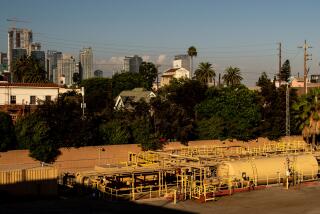Testing of capped oil well is extended
- Share via
Reporting from Atlanta and Venice, La. — A crucial two-day test of BP’s troubled gulf oil well was extended Saturday by 24 hours to give experts time to further study pressure readings that could determine whether it is safe to keep a tight seal on top of the well — and keep all of the oil bottled inside.
Former U.S. Coast Guard Adm. Thad Allen, who is heading the federal government’s response to the spill, said in a written statement that 48 hours of testing had provided “valuable information which will inform the procedure to kill the well,” but said that federal experts wanted more time to continue monitoring the results.
Using a massive, custom-made cap, BP was able to fully close off the well Thursday, after 85 days of gushing crude had created one of the nation’s worst environmental disasters.
But the seal carries potential risks: Federal officials are concerned that cracks may have formed in the well’s underground pipes — and that a full seal on top might exacerbate oil flow through those cracks, creating even more leaks on the ocean floor.
At a news conference Saturday, Kent Wells, a BP senior vice president, said there was “no evidence” that the well was damaged or leaking.
Allen’s statement did not fully address what plans the government had for the cap. But he noted that the test had given officials a “better understanding of options for a temporary [well closure] during a hurricane.”
That seemed to indicate that the government and BP may be considering reopening the well, capturing as much oil as they can using a series of pipes and containment ships, and sealing it back up only when big storms force the ships to move to safe harbor.
The troubled Gulf of Mexico well, which had been leaking as much as 60,000 barrels of oil per day until the seal, is about 50 miles off the Louisiana coast, where, historically, the peak of hurricane season runs from August to October.
Allen also said that when the test is “eventually” stopped, “we will immediately return to containment” — that is, using the ships to collect the oil.
It is unclear if that statement precludes the possibility of using the cap to fully seal the well at the top until BP can plug the well from the bottom with a relief well. Allen calls the relief well strategy the “ultimate step in stopping the BP oil leak,” but it might not happen until mid-August.
No one at the New Orleans media center, which is staffed by BP and federal officials, would comment on Allen’s statement. A BP spokesman in Houston also declined to comment.
Wells said Saturday morning that if the company opened the well back up, it would be necessary to “blow [oil] back into the gulf for some period of time” to relieve pressure before the containment ships could be hooked up.
“If we make the decision to open up the well, there will be a period where oil will go back into the gulf,” he said.
Federal officials concerned about new leaks on the ocean floor have required that BP monitor the sea surface extensively during the testing. Robot submarines are scouring for visual evidence of leaks, and seismic and sonar tests are also being conducted.
Wells said there had always been a possibility that the test would be extended beyond 48 hours, and that an extension may help experts learn more about the well.
Inside the well, high-pressure readings may indicate that the well is intact, whereas low-pressure readings probably mean it is broken somewhere.
Wells said a pressure reading of 7,500 pounds per square inch “would really say to us that we do have integrity under, essentially, any scenario.”
The pressure readings inside the well Saturday morning were at 6,745 pounds per square inch and rising slowly. Though relatively good news, he said, that number does not give the clearest answers about what is going on underground.
On Friday, Wells said the numbers seemed to indicate that the well was not leaking, but that the oil reservoir beneath the Earth’s surface was losing pressure after releasing so much oil in the gusher.
He said the federal government would make the final decision about whether to keep the well sealed at the top.
Above water, some anglers on the Louisiana coast were trying to return to a semblance of normal life. On Wednesday, the state opened most Louisiana waters to recreational fishing.
Matthew Freier, 30, of New Orleans docked at Myrtle Grove Marina, red-faced after a full day on the water. He didn’t think the oil had affected his quarry: two redfish.
“The fishing was like it always is,” the medical student and self-proclaimed “weekend warrior” said. “Sometimes you get a mess of them, sometimes you don’t.”
But Freier was hoping for better odds when it came to the well.
“I wish BP and the government would get it figured out,” he said.
Fausset reported from Atlanta and Santa Cruz from Venice.
More to Read
Sign up for Essential California
The most important California stories and recommendations in your inbox every morning.
You may occasionally receive promotional content from the Los Angeles Times.














